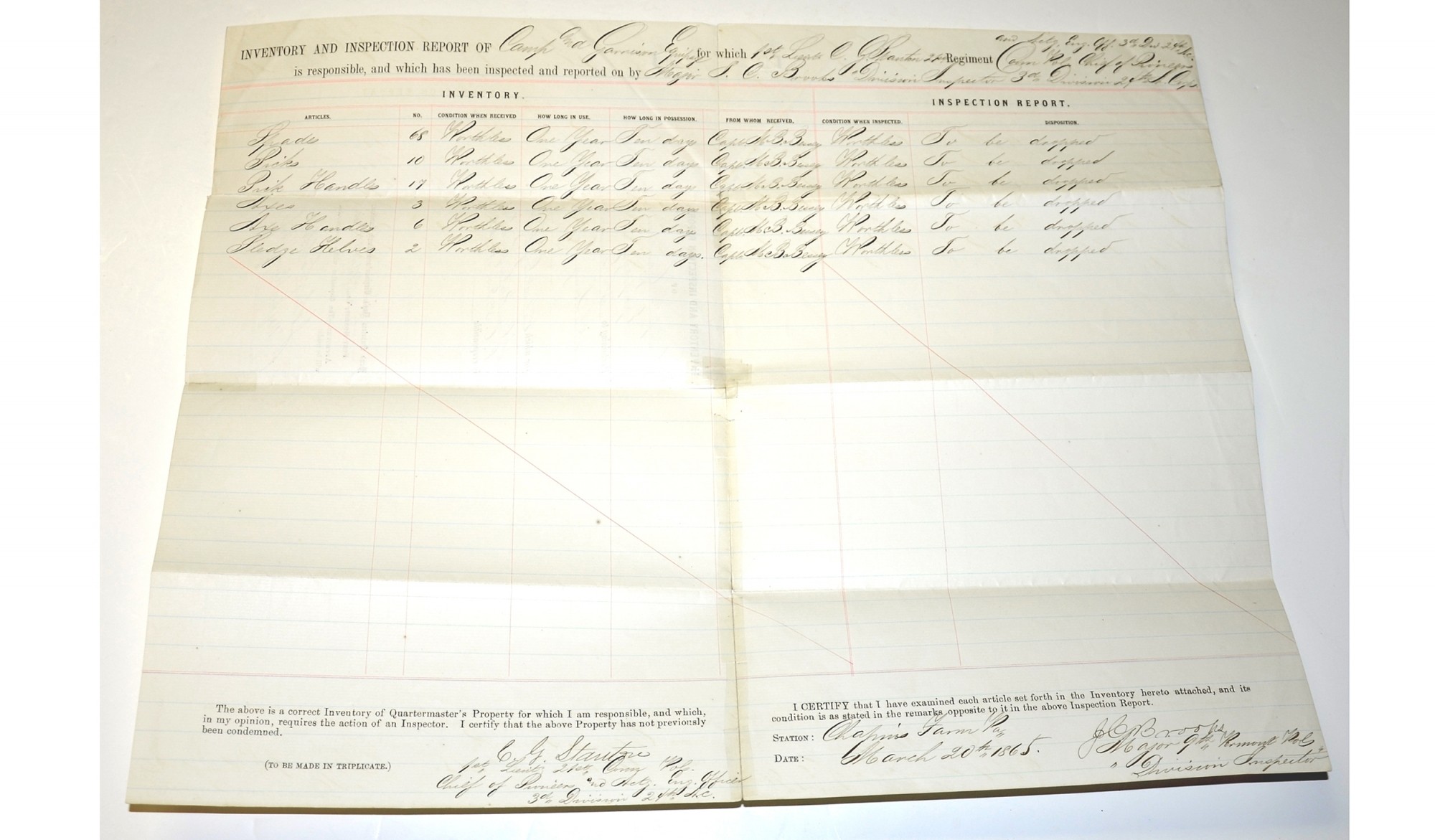site search
online catalog
DOCUMENT SIGNED BY MAJOR GENERAL JOHN GIBBON

$500.00 SOLD
Quantity Available: None
Item Code: L14565
Document is an Inventory and Inspection Report of Camp and Garrison Equipment pertaining to the 24th Army Corps for which 1st Lieutenant C. G. Stanton, 21st Connecticut and Chief of Pioneers 3rd Division, 24th Corps is responsible.
Document is preprinted and entirely filled out in ink. It is dated March 24, 1865. When unfolded it meas. approx. 16.00 x 12.75 inches. The document has one vertical and three horizontal folds. Three of the horizontal folds have small amounts of separation on the very ends otherwise all folds are still good.
Gibbons signature appears on the front bottom of the document after it is folded. Signature is in strong and flowing ink in two lines that reads “JOHN GIBBON / MAJ GEN COMDG CORPS.”
John Gibbon was born April 20, 1827 in Philadelphia, Pennsylvania. When he was ten, his father accepted a position at the U.S. Mint in Charlotte, North Carolina and relocated the entire family there. In 1842, Gibbon received an appointment to the U.S. Military Academy. He graduated in the middle of his class in 1847 and was made a 2nd Lieutenant of artillery. He served in the Mexican and Seminole Wars and was in Texas before returning to West Point in 1854 to teach artillery tactics. Gibbon published a book titled “The Artillerist’s Manual” in 1859. This text was widely read and used by both sides during the Civil War.
Following the bombardment of Fort Sumter in April 1861, Gibbon, in spite of the fact that his father was a slaveholder and three of his brothers and his cousin [J. Johnston Pettigrew] went on to fight for the Confederacy, upheld his oath to the United States and reported to Washington for assignment. He was made Chief of Artillery for Major General Irvin McDowell, and a year later was promoted to Brigadier General of Volunteers and placed in command of the famous “Iron Brigade.” He led the brigade at Brawner’s Farm, Second Manassas, South Mountain and Antietam, where Gibbon himself personally manned an artillery piece.
Late in 1862, Gibbon was promoted to command of the 2nd division, 1st Corps, which he led at Fredericksburg where he was wounded. Returning to duty several months later, Gibbon commanded the 2nd Division of Hancock’s 2nd Corps at Gettysburg, and even directed the Corps itself for brief periods during the battle. On July 3, Gibbon’s men, stationed along Cemetery Ridge, played a significant role in the repulse of Pickett’s Charge, and Gibbon was wounded for a second time.
By the time of the opening of the Overland Campaign of 1864, Gibbon was back in command of his division and led his men at the Wilderness, Spotsylvania Courthouse, Cold Harbor and the investment of Petersburg. In June, 1864, Gibbon was promoted to Major General and in January of the following year was given command of the 24thCorps in the Army of the James.
At the conclusion of the Appomattox Campaign that spring, Gibbon served as one of the surrender commissioners when the Army of Northern Virginia finally succumbed to defeat.
Gibbon remained in the Army until 1891, having served nearly fifty years. In his post-war career, Gibbon, like most regular army men, was primarily engaged with the Indians on the frontier. It was Gibbon’s column who came upon the remains of Custer and his men after Little Big Horn, and Gibbon who led a successful campaign against Chief Joseph and the Nez Perce the following year. He retired in 1891 and moved to Baltimore, where he died on February 6, 1896 and is buried in Arlington National Cemetery.
~~~~~~~~~~~~~~~~~~~~~~~~~~~~~~~~~~~
THIS ITEM, AS WITH ALL OTHER ITEMS AVAILABLE ON OUR WEB SITE,
MAY BE PURCHASED THROUGH OUR LAYAWAY PROGRAM.
FOR OUR POLICIES AND TERMS,
CLICK ON ‘CONTACT US’ AT THE TOP OF ANY PAGE ON THE SITE,
THEN ON ‘LAYAWAY POLICY’.
THANK YOU!
Inquire About DOCUMENT SIGNED BY MAJOR GENERAL JOHN GIBBON
For inquiries, please email us at [email protected]
Most Popular
Historical Firearms Stolen From The National Civil War Museum In Harrisburg, Pa »
Theft From Gravesite Of Gen. John Reynolds »
Cavalry Carbine Sling Swivel »
Fine Condition Brass Infantry Bugle Insignia »
featured item
THE ONLY KNOWN WIDMANN 1840 CAVALRY OFFICER’S SABER: DATED 1844
This is a unique opportunity to acquire a one-of-a-kind U.S. cavalry officer’s saber. Frederick W. Widmann emigrated to the U.S. in 1816 and set up business in Philadelphia as a die-sinker and sword-mounter using imported sword blades by 1825.… (870-279). Learn More »





